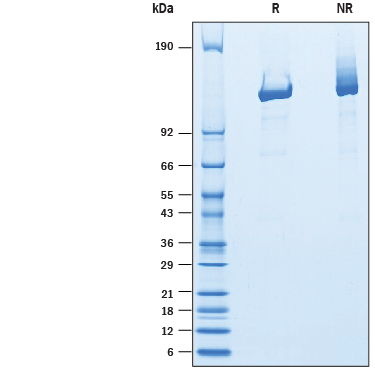Recombinant F. tularensis Cpf1 Protein, CF Summary
Product Specifications
| APKKKRKVGIHGVPAA | F. tularensis Cpf1 (Ser2-Asn1300) Accession # WP_003034647.1 | KRPAATKKAGQAKKKKGG | HHHHHH |
| N-terminus | C-terminus | ||
Analysis
Product Datasheets
Carrier Free
CF stands for Carrier Free (CF). We typically add Bovine Serum Albumin (BSA) as a carrier protein to our recombinant proteins. Adding a carrier protein enhances protein stability, increases shelf-life, and allows the recombinant protein to be stored at a more dilute concentration. The carrier free version does not contain BSA.
In general, we advise purchasing the recombinant protein with BSA for use in cell or tissue culture, or as an ELISA standard. In contrast, the carrier free protein is recommended for applications, in which the presence of BSA could interfere.
10343-C1
| Formulation | Supplied as a 0.2 μm filtered solution in Tris, NaCl, EDTA, Glycerol and TCEP. |
| Shipping | The product is shipped with polar packs. Upon receipt, store it immediately at the temperature recommended below. |
| Stability & Storage: | Use a manual defrost freezer and avoid repeated freeze-thaw cycles.
|
Assay Procedure
- Assay Buffer: 50 mM NaCl, 10 mM Tris-HCl, 10 mM MgCl2, 100 µg/ml BSA, pH 7.9
- Recombinant F. tularensis Cpf1 (rF.t.Cpf1) (Catalog # 10343-C1)
- DNA Substrate: PBR322 vector (NEB, Catalog # N3033S) digested with EcoRI-HF (NEB, Catalog # R3101S)*
- Integrated DNA Technologies (IDT) Alt-R Cpf1 crRNA, targeting sequence: TGCCGCCTCGGCGAGCACAT
- Ultrapure DNase/RNase-Free Distilled Water (Invitrogen, Catalog # 10977015), to prepare Assay Buffer
- DNA gel
- TAE Buffer, 25X Liquid Concentrate (VWR, Catalog # 97062-386)
- Ethidium Bromide, 10 mg/mL (Amresco, Catalog # X328)
*Digest was gel purified using gel purification kit and eluted in EB buffer (10 mM Tris-HCl, pH 8.5).
- Prepare RNP Complex:
a. 200 nM crRNA (2 µL addition from 3 µM stock prepared in Assay Buffer)
b. 0.35 µg rF.t.Cpf1
c. Add Assay Buffer for a final RNP Complex volume of 23 µL
d. Incubate for 5 minutes at 25 °C - Mix RNP Complex with 7 µL of 8.6 ng/µL of DNA Substrate (diluted in Assay Buffer, if possible).
- Incubate for 20 minutes at 37 °C.
- Incubate for 10 minutes at 65 °C to dissociate enzyme from DNA.
- Load total reaction with loading dye on a 1.25% agarose gel.
- Run gel at 140V for 40 minutes.
- Soak gel in 200 mL of 1X TAE Buffer with 150 µL of 10 mg/mL Ethidium Bromide for 1 hour.
- Use imaging software to detect and quantify hydrolysis of the DNA substrate.
- rF.t.Cpf1: 0.35 µg
- DNA Substrate: 60 ng
- crRNA: 200 nM
Scientific Data
 View Larger
View Larger
2 μg/lane of Recombinant HumanF. tularensisCpt1 Protein (Catalog # 10343-C1) was resolved with SDS-PAGE under reducing (R) and non-reducing (NR) conditions and visualized by Coomassie® Blue staining, showing bands at 110-135 kDa.
Reconstitution Calculator
Background: Cpf1
Clustered Regularly Interspaced Short Palindromic Repeats (CRISPR)-associated endonuclease from Prevotella and Francisella 1, Cpf1, also known as Cas12a, is a 1200-1500 amino-acids long monomeric protein that belongs to the CRISPR/Cas system (1, 2), an adaptive immune system of prokaryotes that has now become a powerful tool for genome editing (3). CRISPR/Cpf1 belongs the class II (type 5) of the CRISPR/Cas system that is defined by a single-subunit effector (4). Cpf1 has recently emerged as an alternative for Cas9, due to its distinct features (2, 5) such as the ability to target T-rich motifs, no need for trans-activating crRNA, inducing a staggered double-strand break and potential for both RNA processing and DNA nuclease activity. In addition, Cpf1 is able to process more structured pre-CRISPR/RNA(crRNA) molecules into mature crRNAs (6) which allows the possibility to use both mature or pre-crRNA for genome editing purposes(7). All these features make the CRISPR-Cpf1 system a valuable genome-engineering tool (8). CRISPR-Cpf1(Cas12a) has been successfully used to edit genomes in mammalians cells (2), plants (9), mice (10), Drosophila (11) and recently zebrafish and Xenopus (7). Two Cpf1 orthologs have been commonly used for genome editing in different organisms: AsCpf1 and LbCpf1, which are derived from Acidaminococcus sp. BV3L6 and Lachnospiraceae bacterium ND2006, respectively (8).The attached nuclear localization signals (NLSs) on the chimeric protein ensures nuclear compartmentalization in cells during gene editing (12).
- Jinek, M. et al. (2012) Science 337:816.
- Zetsche, B. et al. (2015) Cell 163:759.
- Sandler J.D. and Joung J.K. (2014) Nat Biotechnol. 32:347.
- Koonin E.V. et al. (2017) Curr. Opin. Micrbiol. 37:67.
- Bayat H. et al. (2018) Curr. Micribiol. 75:107.
- Fonfara, I. et al. (2016) Nature 532:517.
- Moreno-Mateo, M.A. et al. (2017) Nat. Commun 8:2024.
- Joung K.J. et al. (2016) Nat. Biotechnol. 34:869.
- Kim, H et al. (2017) Nat. Commun. 8:14406.
- Kim, Y. et al. (2016) Nat. Biotechnol. 34:808.
- Port, F. and Bullock, S.L. (2016) Nat Methods 13:852.
- Cong, L. et al. (2013) Science 339:819.
FAQs
No product specific FAQs exist for this product, however you may
View all Proteins and Enzyme FAQsReviews for Recombinant F. tularensis Cpf1 Protein, CF
There are currently no reviews for this product. Be the first to review Recombinant F. tularensis Cpf1 Protein, CF and earn rewards!
Have you used Recombinant F. tularensis Cpf1 Protein, CF?
Submit a review and receive an Amazon gift card.
$25/€18/£15/$25CAN/¥75 Yuan/¥2500 Yen for a review with an image
$10/€7/£6/$10 CAD/¥70 Yuan/¥1110 Yen for a review without an image
